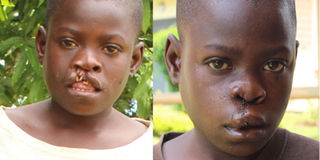Prevent birth defects like cleft lip by taking folic acid

Brian says he faced alot of teasing before the surgery. After surgery, Brian can finally live confidently. PHOTOS/COURTESY
Brian Kitone, 10, from Mubende District will forever be grateful for the day he met a kind stranger. “One day, as we came from the well, a man saw Brian and stopped to talk to us. He said Brian’s lip could be fixed if only we found our way to the hospital,” Grace Samanya, his sister, shares.
“The next hurdle was getting transport to CoRSU Hospital in Entebbe but through a pastor, we not only got it but also money for feeding while there,” Samanya says.
New to Kampala and unsure of what to expect, they are forever thankful to the taxi that took them to the hospital and the official that welcomed them. “We were admitted and Brian’s surgery was scheduled. After a few days, we were discharged with medicine to quicken the healing process.”
At birth
Cleft lip, according to Dr Joseph Mbuga, a plastic and reconstructive surgeon, is a condition in which a baby is born with a split/opening in the lip while cleft palate is where the split or opening is on the roof of the mouth. It is a result of failure of fusion or union of the tissues that make the face during the first eight weeks of development of the baby in the womb.
“The split in the lip may have varying severity from involvement of part of the lip segment (incomplete cleft lip) to involvement of the whole lip extending into the floor of the nose and the gum (complete cleft lip). However, this split in the lip may also extend into the roof of the mouth.
When the two conditions occur together in the same patient, it is called a cleft lip and palate. A similar split can happen in the roof of the mouth without involvement of the lip. This is called an isolated cleft palate,” Dr Cornelius Masambu, a plastic and reconstructive surgeon, says.
Unfortunately, the exact cause of cleft lip and or palate is unknown. However, Dr Mbuga says there are factors that increase the risk of a mother giving birth to a baby with a cleft lip and/or palate.
These include genetic factors where having a close relative with a cleft lip increases the risk, mother’s advanced age, smoking during pregnancy, uncontrolled high blood sugar during pregnancy and mothers who do not take folic acid during pregnancy.
Preventative measures
With the exact cause unknown, prevention is difficult. However, avoiding some of the risk factors mentioned above may help.
“One precautionary measure could be for mothers to attend antenatal, especially in the first two months of pregnancy. In case a baby has cleft lip/palate, a good antenatal ultrasound scan can help the mother know before birth, which is crucial for planning the delivery and after care,” Dr Mbuga explains.
Caution
However, Dr Mbuga says, children that only have an opening in the roof of the mouth may be hard to identify. “Therefore, it is necessary for the attending health worker to always examine the newborn’s mouth to avoid missing this problem. Otherwise, if missed these babies will usually present with failure or difficulty to breastfeed or spillage of breast milk through the nose followed by poor growth.”
Challenges for babies
Besides abnormal appearance, which definitely affects the mother-child social interaction and acceptance hence indirectly affecting the mother’s care for the newborn, Dr Masambu says there are more direct effects of a cleft lip or palate on the health and wellbeing of the baby with it.
He adds that the baby is unable to latch on to the breast, create an air tight seal around the nipple, press the nipple between the tongue and the roof of the mouth to create a negative suction pressure in the mouth necessary for effective breastfeeding. As a result, these babies use a lot of energy in an attempt to breastfeed and swallow more air than breast milk.
On the other hand, because of the communication between the nose and mouth as well as challenges with swallowing, these children get recurrent flu, cough and pus from the ears. “All these factors combined result in massive rapid weight loss that is difficult to correct and may result into death from malnutrition and its effects if nothing is done,” Dr Masambu explains.
Additionally, if the cleft palate is not repaired, he says it is impossible for these children to speak well and this greatly affects their social interaction, self-esteem and social acceptance. Besides, as the teeth develop, there are disorganised and prone to recurrent dental cavities because of poor oral hygiene.
Interventions
Besides surgery, Dr Rose Nazziwa, a paediatrician, says the single most important intervention in the care of these babies is nutrition management, which involves assessment of nutrition status of each child, training the mother about preparation of age appropriate nutritious feeds to supplement expressed breastmilk, feeding techniques and positioning, provision of specialised bottles as well as ongoing follow up and assessment.
Surgery helps to correct the anatomical defects while speech training improves the speech outcome and swallowing problems.
Sylivia Nafuna, a social worker, says psychosocial support and counselling helps parents to come to terms with the daily challenges as well as community reintegration, fighting stigma and soliciting for family as well as community support.
“It should be emphasised that collaboration with other specialists such as cardiologists and cardiac surgeons is paramount as there are many other conditions that can be associated with cleft lip or palate,” Dr Masambu concludes.
[email protected]




